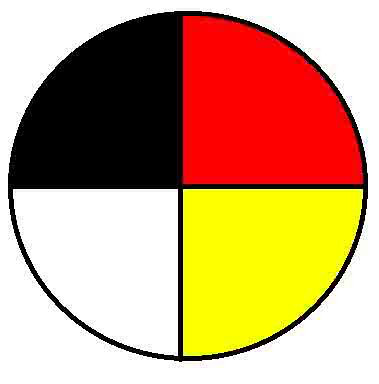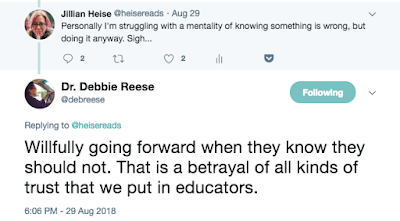I used to teach at the Indian Community School of Milwaukee (ICS). My four years there were a time of intense personal & professional growth for me, and being invited to be a part of that community was incomparable. I was familiar with some traditions of Tribal Nations prior to working there for two main reasons: my grandparents lived in Arizona, so growing up I became familiar with some of the Southwest Indian Tribal Nations names and artistic traditions on a surface level, and also because I teach in Wisconsin where Act 31 requires that prospective educators receive training on the history of Tribal Nations in the state prior to earning their teaching certification. {Here are a few fantastic resources for more information on Wisconsin Tribal Nations that could be shared in any state: The Ways: Stories on Culture and Language from Native Communities Around the Great Lakes, Wisconsin First Nations, Great Lakes Indian Fish and Wildlife Commission.}

Even with that, I didn’t even know what I didn’t know about the community traditions of various Native Nations before I started working at ICS. As an intertribal school, there is a bit of a blending of the commonalities of several different tribes, but I also got to spend time learning a Native Language (Menominee – though in the 3 years since I’ve left and not using it, I’ve sadly lost most of my memory of it), being invited to participate in ceremonies and powwows, and receiving teachings through culture mentoring lessons and activities. I loved my time there and getting to work with students and families in that community and infuse culture into all elements of the work, and am still sad to have left. All of this is to give a little bit of context as to why I may be slightly more aware than the average White teacher about concerning and stereotypical representations of First/Native Nations in children’s literature. I also follow Dr. Debbie Reese (Nambe Pueblo) of American Indians in Children’s Literature who is an amazing resource for all of us in breaking down representations of Native characters in books.
To be clear: That doesn’t mean I won’t/don’t still make mistakes. That doesn’t mean I won’t/don’t still miss things (especially coming from an outsider perspective, there are things I would never be able to know). This is not to say I don’t still have much I can learn. But, I am concerned.
With the realization that this post is somewhat centering my White perspective, those are also the teachers I’m talking to. I am concerned about the number of teachers I see recommending books or putting elements in their schools that are problematic in their representations of First/Native Nations cultures and people or perpetuating stereotypes. But what I’ve come to realize is that so many educators just don’t know (and we could have whole other books about why the systemic oppression and supremacy in this country from its founding have led us to where we are now), but for the purposes of this post, let’s just say we all need to do better. Some educators might just need to do more Google searching to find out if there are critiques of books we’re considering using (Debbie’s blog is a great place to start). And some might need to move past the nostalgia of books we have fond memories of and realize they are problematic with our new lenses of looking at them. And all educators need to remember that we are dealing with impressionable kids and generational white supremacy is an issue, especially when any reference to “Indians” or Tribal Nations is done in a historical viewpoint that erases them as contemporary, sometimes urban, people. Really it comes down to this: We should all be doing our best to learn, grow, become more critical consumers, and get better at this whole thing, while never compromising the stance that affirming the humanity and lived experiences of ALL kids should be at the center of our work.

To help with that, I decided to make a post compiling a few picture book recommendations for using in #classroombookaday read alouds, so I have one spot to direct people to. Because my students’ humanity should not up for debate, and anything that works against that should not be in a classroom or library. As Elisa Gall succinctly reminded on twitter tonight:

So I’m sharing some #ownvoices picture books
that present positive, contemporary representations
of First/Native Nations culture and characters and creators
that are powerful books to read aloud with students.

A look at modern Native American life as told by a citizen of the Cherokee Nation
The word otsaliheliga (oh-jah-LEE-hay-lee-gah) is used by members of the Cherokee Nation to express gratitude. Beginning in the fall with the new year and ending in summer, follow a full Cherokee year of celebrations and experiences.
Appended with a glossary and the complete Cherokee syllabary, originally created by Sequoyah.
The sun on your face. The smell of warm bannock baking in the oven. Holding the hand of someone you love. What fills your heart with happiness? This beautiful board book, with illustrations from celebrated artist Julie Flett, serves as a reminder for little ones and adults alike to reflect on and cherish the moments in life that bring us joy.International speaker and award-winning author Monique Gray Smith wrote My Heart Fills with Happiness to support the wellness of Indigenous children and families, and to encourage young children to reflect on what makes them happy.

Nimoshom loved to drive the school bus. Every day, on the way to and from school, he had something to say. Sometimes, he told the kids silly stories. Sometimes, he taught the kids a new word in Cree.
“Nimoshom and His Bus” introduces basic Cree words. A glossary is included in the back of the book.

Go on a Mission to Space with Chickasaw astronaut John Herrington, as he shares his flight on the space shuttle Endeavor and his thirteen-day mission to the International Space Station. Learn what it takes to train for space flight, see the tasks he completed in space, and join him on his spacewalk 220 miles above the earth.

Windy Girl is blessed with a vivid imagination. From Uncle she gathers stories of long-ago traditions, about dances and sharing and gratitude. Windy can tell such stories herself–about her dog, Itchy Boy, and the way he dances to request a treat and how he wriggles with joy in response to, well, just about everything.
When Uncle and Windy Girl and Itchy Boy attend a powwow, Windy watches the dancers and listens to the singers. She eats tasty food and joins family and friends around the campfire. Later, Windy falls asleep under the stars. Now Uncle’s stories inspire other visions in her head: a bowwow powwow, where all the dancers are dogs. In these magical scenes, Windy sees veterans in a Grand Entry, and a visiting drum group, and traditional dancers, grass dancers, and jingle-dress dancers–all with telltale ears and paws and tails. All celebrating in song and dance. All attesting to the wonder of the powwow.
This playful story by Brenda Child is accompanied by a companion retelling in Ojibwe by Gordon Jourdain and brought to life by Jonathan Thunder’s vibrant dreamscapes. The result is a powwow tale for the ages.

Circles are all around us. We just have to look for them. Sometimes they exist in the most unusual places.
Grandpa says circles are all around us. He points to the rainbow that rises high in the sky after a thundercloud has come. “Can you see? That’s only half of the circle. That rest of it is down below, in the earth.” He and his granddaughter meditate on gardens and seeds, on circles seen and unseen, inside and outside us, on where our bodies come from and where they return to. They share and create family traditions in this stunning exploration of the cycles of life and nature.

“I like to eat, eat, eat,” choruses young Johnny as he watches Grandma at work in the kitchen. Wild rice, fried potatoes, fruit salad, frosted sweet rolls—what a feast! Johnny can hardly contain his excitement. In no time, he’ll be digging in with everyone else, filling his belly with all this good food.
But wait. First there is the long drive to the community center. And then an even longer Ojibwe prayer. And then—well, young boys know to follow the rules: elders eat first, no matter how hungry the youngsters are. Johnny lingers with Grandma, worried that the tasty treats won’t last. Seats at the tables fill and refill; platters are emptied and then replaced. Will it ever be their turn? And will there be enough?
As Johnny watches anxiously, Grandma gently teaches. By the time her friend Katherine arrives late to the gathering, Johnny knows just what to do, hunger pangs or no. He understands, just as Grandma does, that gratitude, patience, and respect are rewarded by a place at the table—and plenty to eat, eat, eat.
Writer and beadwork artist Cheryl Kay Minnema is a member of the Mille Lacs Band of Ojibwe. Artist Wesley Ballinger, also a member of the Mille Lacs Band, works for the Great Lakes Indian Fish and Wildlife Commission.

This vibrant picture book, beautifully illustrated by celebrated artist Danielle Daniel, encourages children to show love and support for each other and to consider each other’s well-being in their everyday actions.
Consultant, international speaker and award-winning author Monique Gray Smith wrote You Hold Me Up to prompt a dialogue among young people, their care providers and educators about reconciliation and the importance of the connections children make with their friends, classmates and families. This is a foundational book about building relationships, fostering empathy and encouraging respect between peers, starting with our littlest citizens.

Set in the Okanagon, BC, a First Nations family goes on an outing to forage for herbs and mushrooms. Grandmother passes down her knowledge of plant life to her young grandchildren.

Tink, tink, tink, tink, sang cone-shaped jingles sewn to Grandma Wolfe’s dress.
Jenna’s heart beats to the brum, brum, brum, brum of the powwow drum as she daydreams about the clinking song of her grandma’s jingle dancing.
Jenna loves the tradition of jingle dancing that has been shared by generations of women in her family, and she hopes to dance at the next powwow. But she has a problem—how will her dress sing if it has no jingles?
The warm, evocative watercolors of Cornelius Van Wright and Ying-Hwa Hu complement author Cynthia Leitich Smith’s lyrical text as she tells the affirming story of how a contemporary Native American girl turns to her family and community to help her dance find a voice.

The determined story of an Ojibwe grandmother (nokomis), Josephine Mandamin, and her great love for nibi (water). Nokomis walks to raise awareness of our need to protect nibi for future generations and for all life on the planet. She, along with other women, men and youth, has walked around all the Great Lakes from the four salt waters, or oceans, to Lake Superior. The walks are full of challenges, and by her example she challenges us all to take up our responsibility to protect our water, the giver of life, and to protect our planet for all generations.
I hope you enjoy these books and find a way to share them with students. And I hope this post has given you something to consider when selecting books with First/Native Nations content and characters, and that you’ll seek out information to determine if they are accurate and positive representations before sharing with kids. We can all still learn, and once we do, we need to act with the new information to do better. I hope this list will help you in your efforts.
(thank you in Menominee)
























